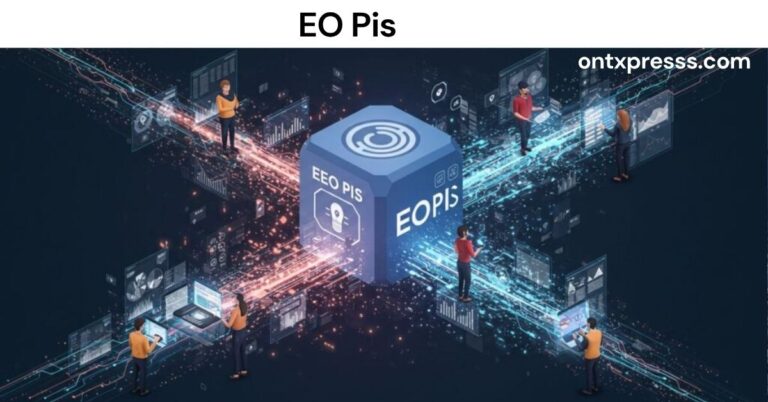In recent years, sustainability has become a core focus for organizations around the world. As concerns about climate change, resource depletion, and environmental degradation continue to grow, businesses are under increasing pressure to adopt environmentally responsible practices. One of the most effective ways to track and assess sustainability efforts is through the use of EO Pis (Environmental Objectives and Performance Indicators).
EO Pis are a critical part of sustainability frameworks, helping organizations set clear environmental goals and measure their performance against these targets. By establishing clear objectives and quantifiable performance indicators, businesses can effectively manage their environmental impacts and work toward achieving their sustainability goals.
This article will provide a comprehensive breakdown of EO Pis, explore their components, and discuss how they can be used to promote sustainability in different sectors.

What Are Environmental Objectives and Performance Indicators (EO Pis)?
At its core, EO Pis consist of two key elements:
Environmental Objectives (EO):
These are the specific goals an organization sets to achieve within a defined time frame. They focus on minimizing negative environmental impacts, conserving natural resources, reducing emissions, and enhancing sustainability across operations. Examples of environmental objectives include reducing water consumption, lowering carbon emissions, or increasing the use of renewable energy.
Also Read: Ontpress FreshUpdates: Real-Time News, Personalized Content, and Engaging Multimedia
Performance Indicators (PIs):
These indicators measure the progress of the organization in achieving its environmental objectives. PIs provide quantifiable data on environmental performance, helping organizations assess whether they are meeting their targets. For example, a performance indicator could be the percentage reduction in CO2 emissions or the amount of waste diverted from landfills.
Together, EO Pis offer a structured way to measure and manage environmental performance. They ensure that businesses are not only setting sustainable objectives but also tracking and improving their progress over time.
Components of EO Pis
For EO Pis to be effective, they must include clear, measurable, and time-bound goals. Below are the key components that make up EO Pis:
Clear Environmental Objectives:
- Each environmental objective should be specific, measurable, achievable, relevant, and time-bound (SMART). These objectives provide a clear direction for the organization and ensure that all stakeholders are aligned with the sustainability vision.
Quantifiable Performance Indicators:
- Performance indicators should provide precise measurements that reflect the organization’s progress toward achieving environmental objectives. These could include metrics such as:
- Energy consumption (kWh)
- Water usage (liters)
- Waste generation (tons)
- Carbon emissions (tons of CO2)
- Energy consumption (kWh)
Data Collection and Reporting:
- Accurate data collection is essential for measuring performance. Organizations need reliable systems in place to gather data on various environmental factors. Regular reporting allows organizations to track progress, identify challenges, and make informed decisions to improve their sustainability efforts.
Review and Continuous Improvement:
EO Pis are not set in stone. As organizations progress toward their environmental objectives, it’s essential to periodically review and revise objectives and performance indicators. This ensures that they remain relevant, realistic, and aligned with the organization’s sustainability goals.
How Do EO Pis Benefit Organizations?
- Track Progress Toward Sustainability Goals:
- EO Pis enable businesses to measure how well they are performing in terms of sustainability. Whether it’s reducing greenhouse gas emissions or improving waste management practices, EO Pis provide the data needed to track these efforts.
- EO Pis enable businesses to measure how well they are performing in terms of sustainability. Whether it’s reducing greenhouse gas emissions or improving waste management practices, EO Pis provide the data needed to track these efforts.
- Improve Operational Efficiency:
- By setting clear environmental objectives and performance indicators, organizations can pinpoint areas where efficiency can be improved. For example, reducing water or energy usage often leads to cost savings while also benefiting the environment.
- By setting clear environmental objectives and performance indicators, organizations can pinpoint areas where efficiency can be improved. For example, reducing water or energy usage often leads to cost savings while also benefiting the environment.
- Enhance Transparency and Accountability:
- EO Pis foster transparency in an organization’s sustainability efforts. They provide a clear framework for accountability, enabling stakeholders to assess the company’s commitment to environmental performance.
- EO Pis foster transparency in an organization’s sustainability efforts. They provide a clear framework for accountability, enabling stakeholders to assess the company’s commitment to environmental performance.
- Support Regulatory Compliance:
- Many industries are subject to regulations related to environmental sustainability. EO Pis help organizations ensure compliance with environmental laws and standards by regularly measuring their performance and adhering to guidelines.
- Many industries are subject to regulations related to environmental sustainability. EO Pis help organizations ensure compliance with environmental laws and standards by regularly measuring their performance and adhering to guidelines.
- Boost Reputation and Competitive Advantage:
- Companies that actively track and improve their environmental performance using EO Pis demonstrate a commitment to sustainability. This can enhance the organization’s reputation and appeal to environmentally-conscious consumers and investors.
- Companies that actively track and improve their environmental performance using EO Pis demonstrate a commitment to sustainability. This can enhance the organization’s reputation and appeal to environmentally-conscious consumers and investors.
Also Read: Understanding Cumhuritey: Political, Cultural, and Social Impact on National Identity
Real-World Examples of EO Pis in Action
Corporations:
Large corporations like Nike, Apple, and Unilever use EO Pis to track and improve their environmental performance. For example, Nike has set ambitious goals for reducing its carbon footprint, water usage, and waste production. By using performance indicators, they are able to quantify progress and set new targets as they strive for greater sustainability.
Government Agencies:
Government agencies also use EO Pis to manage their sustainability efforts. The U.S. Environmental Protection Agency (EPA) sets environmental objectives related to air quality, water conservation, and waste management, and uses performance indicators to measure progress toward meeting national environmental goals.
Small and Medium Enterprises (SMEs):
Smaller companies are increasingly adopting EO Pis as part of their sustainability efforts. For instance, a small manufacturing company may set an objective to reduce energy consumption by 10% within the next year and use performance indicators to track monthly energy usage.
Best Practices for Implementing EO Pis
Set Realistic and Achievable Targets:
It is essential to set objectives that are both challenging and achievable. Setting unrealistic goals can lead to frustration and reduced motivation among employees and stakeholders.
Engage Stakeholders:
Involving employees, suppliers, and customers in sustainability efforts can create a sense of shared responsibility. Engaging stakeholders helps to ensure that sustainability objectives are integrated into the company culture.
Use Technology for Data Tracking:
Utilize data management software to collect, analyze, and report on environmental performance. This can streamline the process and improve the accuracy of the data being tracked.
Continually Review and Adapt:
Regular reviews are necessary to ensure that objectives remain relevant and that performance indicators provide meaningful insights. As new environmental challenges and opportunities arise, the EO Pis framework should be adapted accordingly.
Also Read: Global Sourcing Simplified: How Lianjie Supply Chain Empowers Modern Businesses
FAQs About EO Pis
What is the difference between EO Pis and traditional performance indicators?
EO Pis specifically focus on measuring environmental impact and sustainability efforts, whereas traditional performance indicators may cover a wide range of organizational activities, such as sales, revenue, or employee productivity.
How can small businesses implement EO Pis?
Small businesses can start by setting simple, clear environmental objectives, such as reducing energy usage or waste. They can then track progress using performance indicators like electricity consumption or the amount of waste diverted from landfills.
Are EO Pis legally required?
While EO Pis are not mandatory for all businesses, they are highly encouraged in industries where sustainability is a key concern. In some regions, certain environmental reporting requirements may require businesses to measure and report their environmental performance.
What tools can organizations use to track EO Pis?
Many organizations use Environmental Management Systems (EMS), such as ISO 14001, to help track and report their environmental performance. Additionally, businesses may use specialized software tools to monitor key metrics.
How often should EO Pis be reviewed?
EO Pis should be reviewed on a regular basis, ideally annually. However, for organizations that are rapidly evolving or facing new environmental challenges, more frequent reviews may be necessary.
Conclusion
EO Pis (Environmental Objectives and Performance Indicators) provide a powerful framework for organizations looking to track and improve their environmental performance. By setting clear objectives and using quantifiable performance indicators, businesses can measure their progress, identify areas for improvement, and ultimately work toward a more sustainable future. Whether you are part of a large corporation, a government agency, or a small business, adopting EO Pis can help you make meaningful strides toward achieving your environmental goals.
